20 ways to free up RAM on Windows 10 computers, reset Windows 10 RAM in the simplest way
Whether the computer is fast or slow, opening heavy software or games without freezing depends on the CPU processor and RAM memory. Large and fast RAM memory will help increase the computer's processing speed, and vice versa, full RAM memory will cause the computer to slow down and freeze.
In this article, Tipsmake will introduce to you 17 ways to free up RAM memory to help your computer run faster and smoother.
1. Control which programs start with Windows
The more software you install on your computer, the longer it takes for Windows to start up. Many programs add themselves to the list of programs that are started when you boot your computer, and that list can grow over time.
For some programs, it's better if they start with Windows, such as firewall and antivirus software. However, for most programs, starting them at boot time just wastes resources and prolongs startup time. There is a tool installed with Windows, called MSConfig, that allows you to quickly and easily see what is running at startup and disable programs you want to run automatically after startup if necessary. This tool is available and can be used to disable startup programs in Windows 7, Vista and XP. If you're using Windows 8 or Windows 10, see the other sections below.
NOTE : MSConfig can be used to configure a number of other things besides startup programs, so be careful what you do with it. If you are not sure about using it, just follow the steps in this article and everything will be fine.
Note that some applications need to be configured to stop launching when the computer starts or they will add themselves back to the list of startup programs. In this case, there is usually a setting in the program's options to prevent the program from starting with Windows.
Remove programs that start with Windows
Note, the method is similar to Windows operating system versions.
Step 1:
Go to Start > All programs to remove any unused software.
Step 2:
With Windows 10, enter the MSCONFIG command to search, and from Windows 7 and below you can search for MSCONFIG.EXE in the Run or Search dialog box .
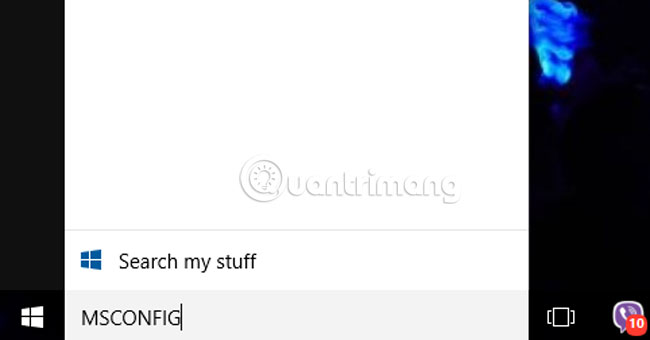
Click the Startup tab to see which software is configured to start with Windows. Windows 7 and below, the software will appear immediately in the Startup panel . As for Windows 10 , click on Open Task Manager to check.
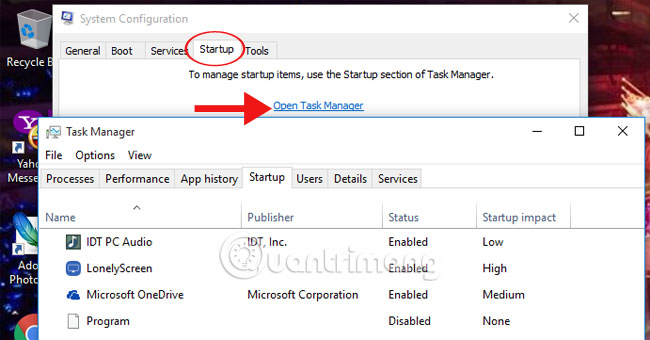
Step 3:
Here, you can control which software is not needed, or set it to not run with Windows at startup by clicking on each program and selecting Disabled .
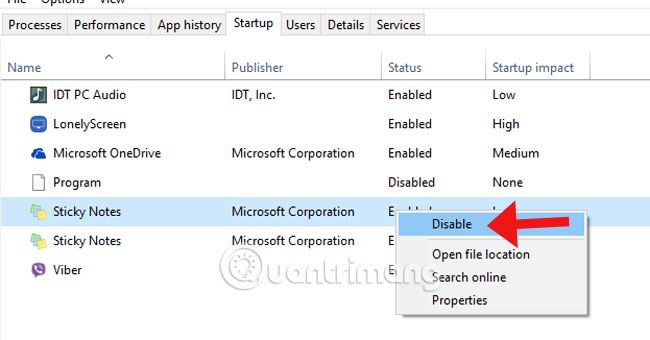
Manage Add-ons utilities:
Add-ons for browsers also consume a lot of RAM. You need to check each Add-ons and disable them if not in use.
Step 1:
At Google Chrome , click on the 3-line icon on the top of the screen, select Settings and access Utilities to check the Add-ons you have been using.
Step 2:
Click the trash icon to delete unused utilities.
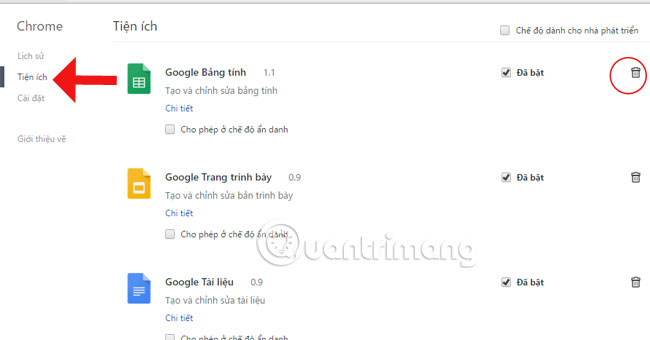
2. Disable unwanted services to free up RAM
Some unnecessary Windows services also cause your computer to run slowly, such as Windows Defender. It takes up about 20MB or even more if you run it in the background. If you already have an anti-virus tool for your computer, you should turn off Defender to speed up your computer . Here's how to disable Windows Defender for Windows versions.
If we decide to disable other services, we can also set them up right on the computer.
Step 1:
In Start enter services.msc to launch. You will see a list of services running in Windows.
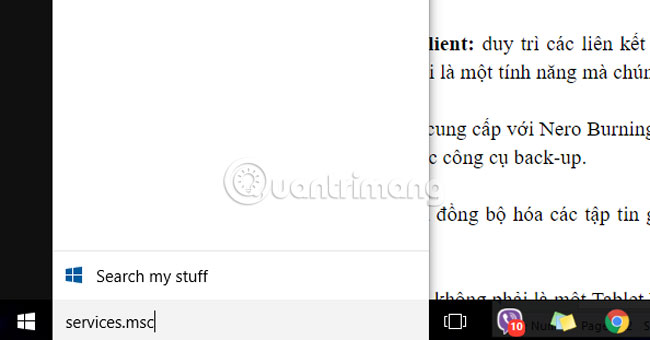
Step 2:
To completely disable a service, right-click an application and select Properties .
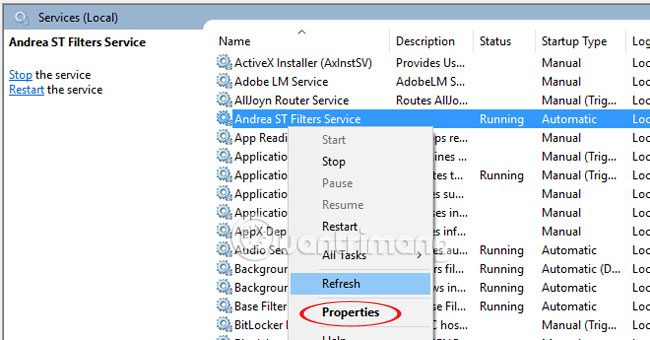
Step 3:
The settings panel appears. In the Startup type section , click the arrow and select Disabled then click OK to complete.
This will disable the program even if you restart your computer.
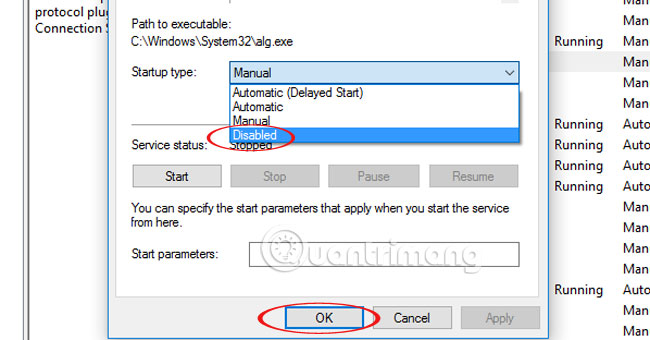
If you want to temporarily disable it, when you restart your computer the service will automatically launch, left click on the service and click on the square on the screen to stop running.
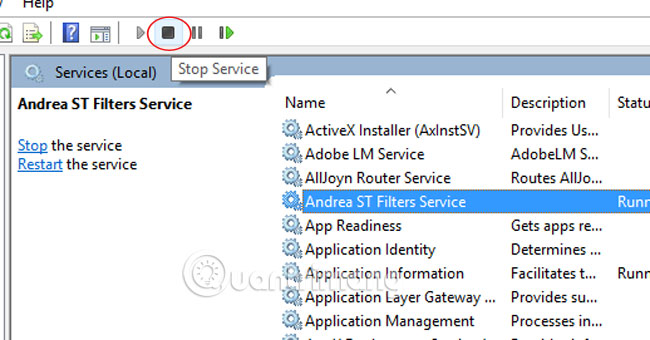
Some services you can consider and completely disable on your computer:
- Apple Mobile Device: comes with iTunes, not necessary if you don't have an Apple device to connect.
- Distributed Link Tracking Client: maintains links between files across a network of domains, not a feature that we use.
- Nero BackItUp Scheduler 3: supplied with Nero Burning ROM, but not needed if you do not use the back-up tool.
- Offline Files: useful if you synchronize files between computers, but we don't need to.
- Tablet PC Input Service: This is not a Tablet PC.
This process probably helps recover 10MB of RAM. You can achieve more if you remove more services, but you also run into dangerous problems if you remove something that is really needed.
3. Reduce hardware requirements
If your PC has 4GB of memory, chances are you're only accessing 3 to 3.5GB of RAM, because the BIOS has allocated the remaining free addresses to the video card, network card, and other hardware.
To check the hardware capacity on your PC, follow these steps:
Step 1:
Enter devmgmt.msc at Start to launch Device Manager .
Step 2:
Click View and select Resources by type to expand memory.
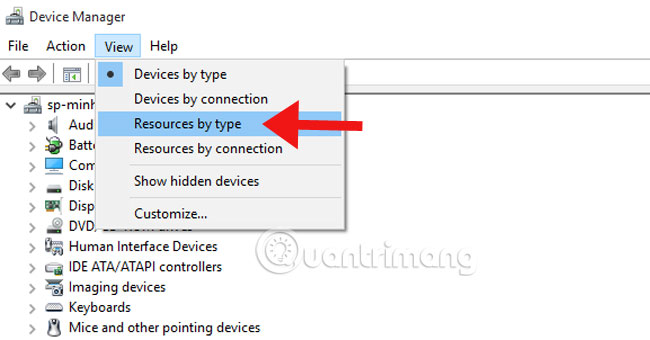
The resources that are cut off are mostly due to the video card. If you have a 512MB graphics card, it will probably take up 512MB or more of your computer's memory drive. This probably won't be a problem if you have 2GB of RAM where no memory is locked, but if you have 4GB it will prevent you from using the full memory.
You can't solve this problem completely, but there are ways to reduce its impact. For example, if you installed an expansion card that you no longer need, remove it. If you're not taking full advantage of your video card, consider downgrading it to a minimum amount of RAM (128MB is enough to run Vista). Check BIOS to turn off unnecessary features. There is a menu usually called Onboard Device Configuration or Integrated Periphrals where you can disable on-board graphics cards, integrated sound cards, network adapters or unused IDE channels.etc. Use this method to turn off redundant hardware, the BIOS will not allocate memory for them and the capacity will be reserved for you.
4. Turn off unnecessary features to speed up RAM
Don't enable too many Windows features unless you really need it. For example, to speed up Windows Vista , turn off the Aero interface if you can work without it (right-click on the desktop, select Personalize > Theme and select Windows Classic). The computer won't look very nice, but in return saves nearly 40MB of RAM. If watching the network icon flash while transferring data is not necessary, right-click the icon, select Turn Off Activity Animation and you will save 1 to 5MB of RAM.
5. Run Explorer efficiently
Windows Explorer can run each Explorer window in a separate process, so if one window crashes it won't affect the other. It sounds reasonable, but in our testing it used at least an extra 10MB of RAM for every Explorer window you open. If Windows still crashes, find out why, turn off this feature and reclaim the wasted memory.
On Windows 10
Step 1:
Enter the Folder Options command in the search bar to access File Explorer Options .
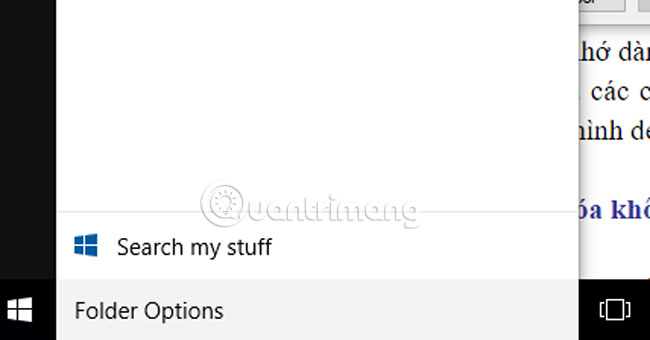
Step 2:
At the File Explorer Options interface , in the View section, uncheck Launch folder windows in a separate process and click OK .
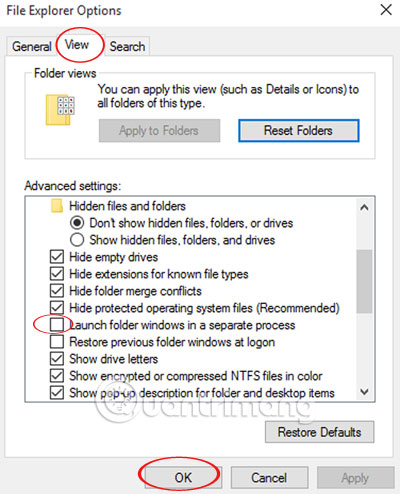
On Windows 7 and below
Step 1:
You access Tools .
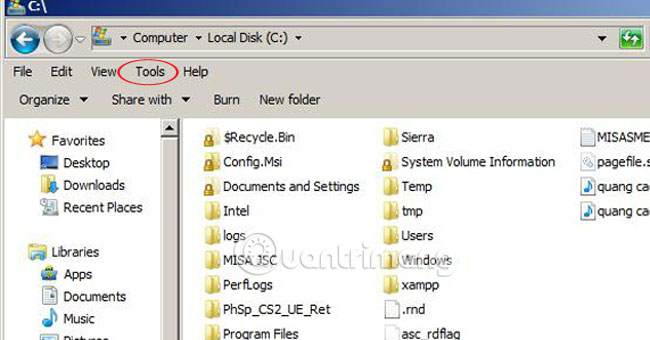
Step 2:
In the Folder Options section , select View and also uncheck Launch folder windows in a separate process, click OK .
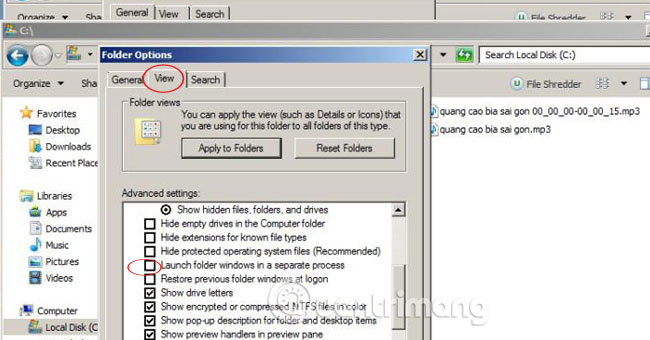
6. Minimize applications
If you're running an app, it's inevitably consuming RAM, but there's a way to reduce that: minimize it. If the application is not doing anything (for example, a browser with a few open tabs), when it is minimized, Windows will reclaim the memory allocated to it to make available to another application. Therefore, it is best to minimize inactive programs rather than leaving its windows on your desktop. This frees up RAM for more necessary tasks.
7. Avoid unclear optimization tools
Don't waste your time with ineffective tricks related to memory optimization or with useless programs that only make things worse.
Some websites recommend the Registry tweak program 'AlwaysUnloadDLL' which claims to help Windows release DLLs immediately after the program using them is closed. But it doesn't work in XP or Vista. Others claim that setting a key to the Windows XP Registry can enable Superfetch (a Windows Vista utility) in Windows XP. That's a myth. Many websites also introduce RAM optimization programs with many promises, but they cannot fix memory errors and cannot 'free up' RAM (in fact, they take up more memory).
8. Monitor your computer
Once you've cleaned up your computer, reboot and see what's using your RAM.
How to do it with Windows 10 version :
Step 1:
Right-click the Start icon under the toolbar and select Task Manager .
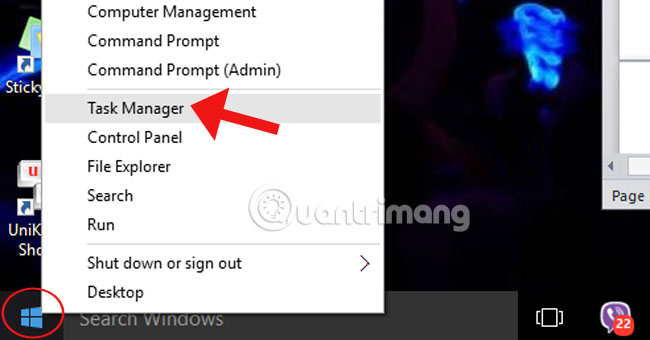
Step 2:
In the Details column you will see the number of programs running on the computer and their capacity.
Click on the Memory section to see the order of software taking up space from low to high, or vice versa.
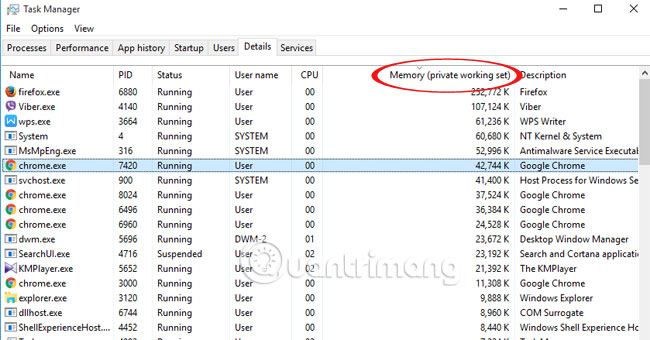
Step 3:
If there is any unnecessary program, you can turn it off. Right-click the program and select End Process tree .
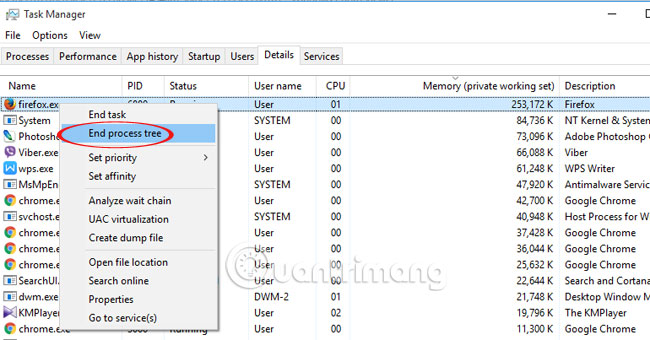
For Windows 7 or lower computers :
Step 1:
With Windows 7 and below, press Ctrl + Shift + Esc to open Task Manager.
Step 2:
Click View and select Select Columns .
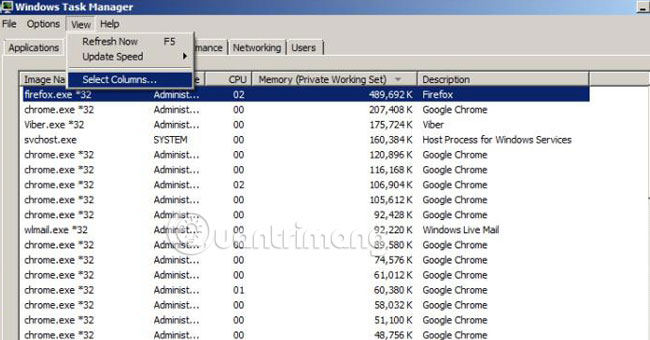
Step 3:
Check the Memory - Private Working Set box and click OK .
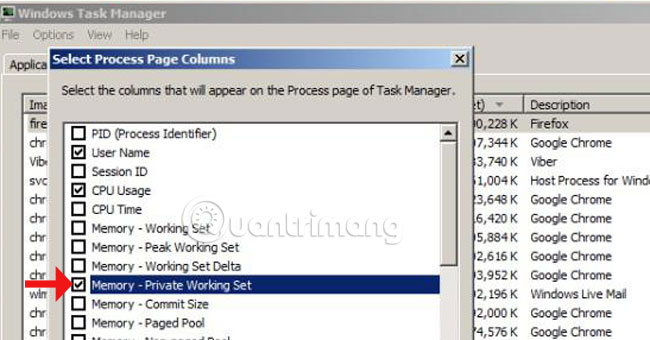
Step 4:
A table will also appear showing how much space the software takes up on your computer. To turn off, right-click and select End Process or End Process Tree .
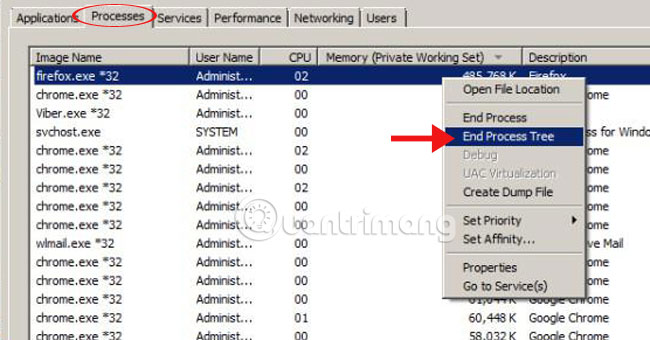
If you really want to dive deep into the workings of your PC, there are two invaluable Sysinternal tools for you. Autoruns displays everything loaded when Windows starts, while Process Explorer displays running programs in great detail and shows you what resources they're using. These are the best computer optimization tools today.
In addition, users can also use CCleaner software to effectively free up RAM, by deleting Windows cache, junk files, and redundant files. How to increase virtual memory capacity and virtual RAM on Windows is also a way to help your computer speed up and play games smoother.
If you have little RAM and can't afford to upgrade RAM, you can consider switching to Opera Neon, the latest version of Firefox or Vivaldi instead of using Chrome, which will also help reduce the burden on RAM.
9. Restart your PC
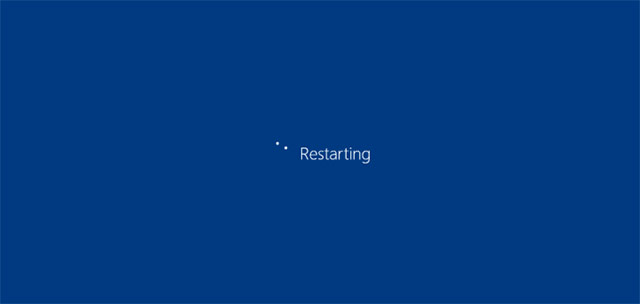
This is a very familiar and simple tip but is especially useful for a number of reasons:
When you restart your computer, the RAM memory on the device will also be automatically cleaned, as well as all running programs will also be reset, thereby helping to clean up the processes running in the computer. The background can be the culprit consuming your system's RAM. It's best to restart your computer regularly to keep the system from getting bogged down with useless applications that frequently run in the background.
10. Scan for malware
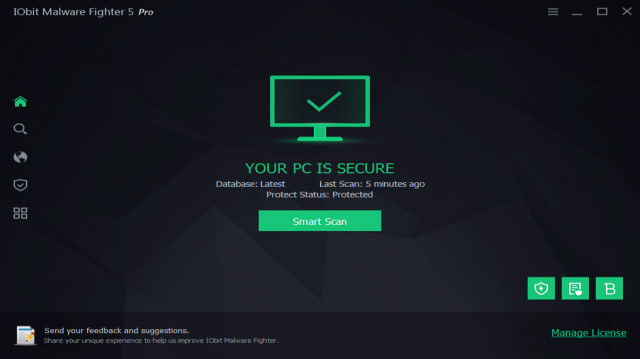
It may sound strange, but controlling malware on the system is also an effective way to free up RAM. Resource-stealing malware will obviously drain your available RAM. Therefore, using anti-virus programs according to a specific, scientific plan is also something you should do.
11. Adjust virtual memory
If you see an error message that your system is not running efficiently on virtual memory, you can definitely improve this and keep your system's performance more stable.
First, access Control Panel (or Settings for Windows 10) from the Start menu. Switch the top right categories view to small icons (if necessary) and select System . On the left side, click Advanced system settings , a new window will open.
Here, in the Advanced tab , click the Settings button under the Performance section . Switch to the Advanced tab again and click the Change button .
You will now see the paging file size for your main drive. In most cases, you can check Automatically manage and let Windows automatically manage these paging files. However, to effectively solve the problem, you should uncheck Automatically manage , then set the initial size and maximum size of the paging files to higher values.
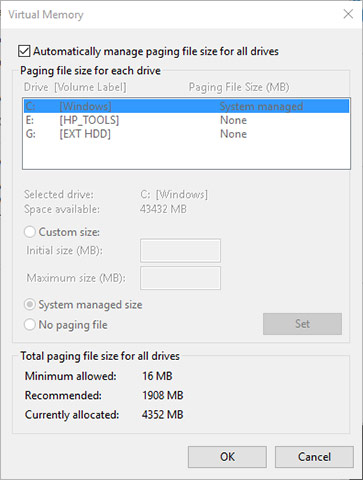
12. Try using ReadyBoost
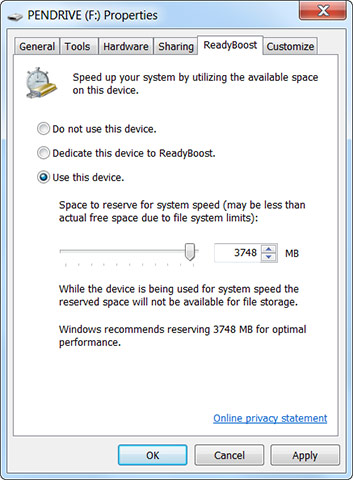
If your computer is still using an older mechanical hard drive (HDD), you can try a little-known but relatively effective Windows feature called ReadyBoost to increase RAM capacity. This feature allows you to use a flash drive or SD card to serve as a secondary RAM system. Although it sounds quite cool, this feature will of course still have limitations. If you are using an SSD, ReadyBoost will have absolutely no effect. This is because SSDs are inherently faster than flash drives.
Furthermore, because today's computers often come with much more RAM by default than before, you won't see as much benefit from ReadyBoost as you would in an older system with less RAM than before. meager built-in ram from a decade ago. "Pretend RAM" from ReadyBoost of course cannot deliver the same performance as real RAM. In short, this method will be more suitable for older computers that have been used for a long time.
13. Install more RAM
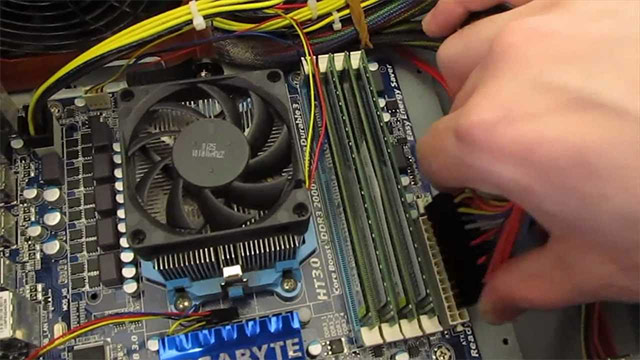
If you really feel low on RAM or want to run more programs at the same time, frankly there is no more effective way than adding more RAM to your system. Although there will be an additional investment cost, adding RAM will help the overall performance of the system improve significantly and be much more sustainable.
If you are using a desktop computer, upgrading RAM will not be difficult at all. But for laptops, it's different. Due to limited space on a laptop, replacing RAM or adding RAM is not simple or even impossible in some cases. In addition, you also need to make sure to buy the right type of RAM that is compatible with your system. Refer to our article 'Instructions on how to upgrade RAM on computers and laptops' to get the most necessary information.
14. Check if anti-virus software is running in the background
Antivirus software is notorious for taking up a lot of resources, especially when it is performing a scan. If your computer suddenly becomes slow, check your antivirus program to see if it is running. If so, stop the antivirus program and schedule the scan to run when the computer is idle.
15. Delete Pagefile when shutting down
A pagefile is an area of the hard drive that Windows uses as extra RAM when physical RAM is full. When you turn off your computer, system RAM is cleared, but the Pagefile is not. Deleting the Pagefile when you shut down your computer will help your computer run more efficiently when you restart your Windows PC.
Refer to the article: Erase Pagefile traces every time you turn off your Windows 10 computer for details on how to do this.
16. Use Game Booster software to pause processes while playing games
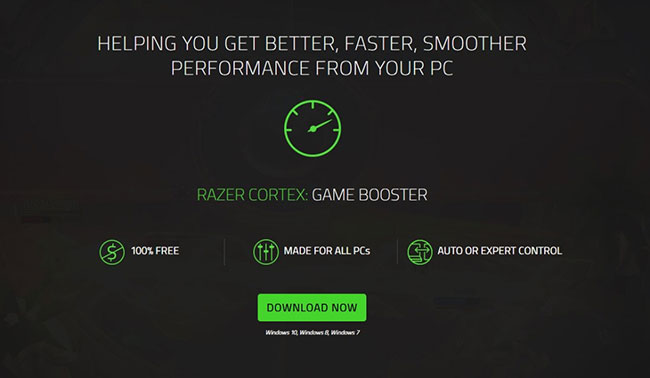
Windows is definitely a great gaming platform. However, unlike console games, the system resources of a laptop or desktop computer are not dedicated to games. Windows services and software running in the background require system resources, which reduces the amount of RAM available for games. Therefore, some players often have to close third-party software and services listed on the Process tab of Task Manager to free up system resources for games.
Apps like Razer Cortex will help you pause all unnecessary background processes before launching the game. So you can have more RAM dedicated to your games. While this doesn't always make a big difference, it's still worth a try. For some people, this method can be extremely helpful.
17. Reduce visual effects
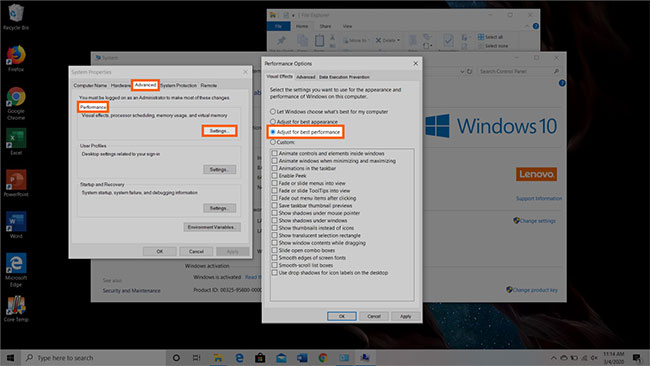
With the improvement of many technologies, it is more likely that computer and visual effects are used. For example, you can turn off animations for apps and icons that use memory for unnecessary effects. If you seem to be running low on RAM, there are some effects you should pause until you can free up more memory.
To access visual effects on your computer:
Step 1 : Open File Explorer.
Step 2 : Right-click This PC on the left panel to select the properties section.
Step 3 : Click Advanced system settings on the left.
Step 4 : Select the Advanced tab.
Step 5 : Select settings in the Performance category.
Step 6 : Change to Adjust for best performance .
This setting will turn off all dynamic features on your computer. This will create more storage space for you but significantly limits the aesthetics of your computer. However, you can also customize the visual effects your computer will perform according to your preferences in the same tab.
18. Update your computer's software
You should update the software on your computer to the latest version. In addition to security reasons, old software versions can cause your computer to need more RAM to process. This leads to a lack of RAM, making your computer slow.
19. Free up RAM by turning off System Restore
On Windows computers, System Restore is a feature that helps your system restore to a specific time to fix problems. This is a useful feature, but it takes up a lot of system resources if enabled. Therefore, you can turn off System Restore to free up RAM space.
Steps to turn off System Restore:
Step 1 : Click the Start button then enter the keyword System Restore or Create a restore point . Click on the search results.
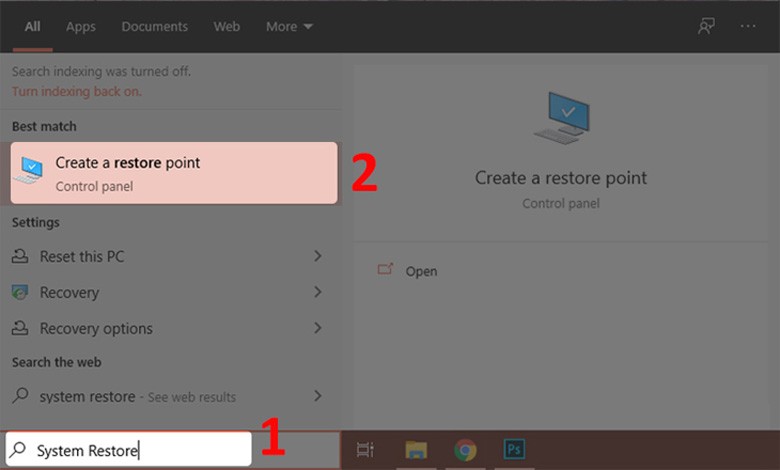
Step 2 : Select the drive you want to turn off System Restore and then click Configure. Next, select " Disable system protection ", select Apply > Yes and then click OK to exit.
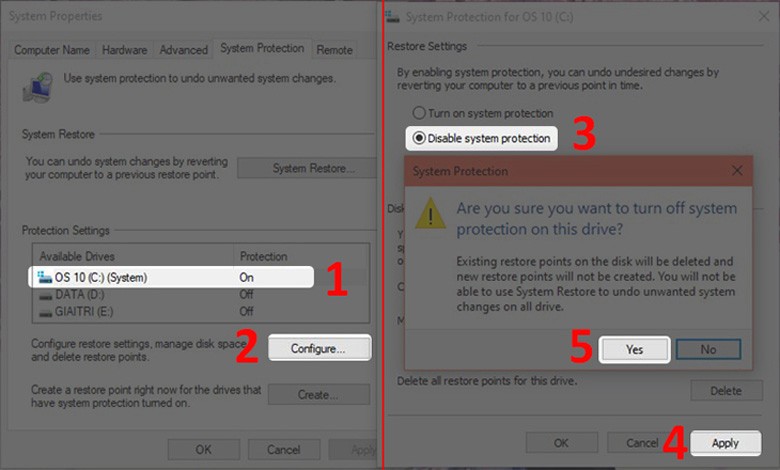
20. Reset the computer
You can reset your computer to restore everything to its original state, your system will be clean and work faster. However, your accounts, applications, and settings will be deleted after performing the reset. You should consider before doing so. How to reset Windows 10 you can refer to here:
Wishing you success! If you encounter any problems that you cannot fix, please leave a comment or contact TipsMake.com via our Facebook fanpage for support.
You should read it
- 13 easy ways to free RAM make the machine run faster
- 8 tricks to 'free' Mac drive
- Good tips for Android devices
- Shared 11 tricks on window 10
- 11 harmless tricks to prank your friends and relatives
- Touchpad tricks for both Windows and Mac
- 7 great Windows 10 tips and tricks that you need to know
- 9 iPhone tricks you may not know
May be interested
- 5 ways to free up & increase RAM for PCs, laptops
 memory in ram is a very important parameter. i will show you 5 ways to free up, as well as improve ram on windows computers.
memory in ram is a very important parameter. i will show you 5 ways to free up, as well as improve ram on windows computers. - 3 How to reset Win 7, Factory reset Windows 7
 if you want to resolve problems in microsoft operating system, improve performance and delete files, you should reset windows 7. tipsmake will guide you how to factory reset windows 7 in the following article.
if you want to resolve problems in microsoft operating system, improve performance and delete files, you should reset windows 7. tipsmake will guide you how to factory reset windows 7 in the following article. - How to reset Windows Search settings on Windows 11
 like any other computer program, windows search can sometimes generate problems that require you to reset its settings to work properly. this article explains two simple ways to reset windows search settings to default.
like any other computer program, windows search can sometimes generate problems that require you to reset its settings to work properly. this article explains two simple ways to reset windows search settings to default. - 4 ways to remove TPM on Windows 11
 the trusted platform module (tpm) is a security chip that helps protect your computer from malware and other attacks.
the trusted platform module (tpm) is a security chip that helps protect your computer from malware and other attacks. - Instructions to reset Windows Store application on Windows 10
 windows store application on windows 10 integrates thousands of free apps, in addition users can buy games, movies, music, tv shows. however, quite recently, many users have reflected that during use, opening windows store often hangs and even closes immediately after opening. during the process of downloading and installing the game, an application from the store often fails.
windows store application on windows 10 integrates thousands of free apps, in addition users can buy games, movies, music, tv shows. however, quite recently, many users have reflected that during use, opening windows store often hangs and even closes immediately after opening. during the process of downloading and installing the game, an application from the store often fails. - Instructions on how to reset Windows 10 extremely fast and simple
 - - like its predecessors, window allows users to reset windows 10 to its original state. this will cause you to lose all data in the windows installation drive, but in return it is a feature to help the computer can work again.
- - like its predecessors, window allows users to reset windows 10 to its original state. this will cause you to lose all data in the windows installation drive, but in return it is a feature to help the computer can work again. - New features of Reset This PC on Windows 10
 the reset this pc feature has been around since windows 8, but it has changed a lot since. microsoft continues to make it better and better. let's find out about the improvements in this feature on windows 10.
the reset this pc feature has been around since windows 8, but it has changed a lot since. microsoft continues to make it better and better. let's find out about the improvements in this feature on windows 10. - Top 5 easiest ways to reset Windows 10 computer password
 knowing simple and effective ways to reset your computer password will help you easily escape the nightmare of resetting your laptop when you forget your password.
knowing simple and effective ways to reset your computer password will help you easily escape the nightmare of resetting your laptop when you forget your password. - Steps to reset all apps on Windows 10
 when the computer encounters many difficult-to-resolve errors, you can reset (reset) all applications on windows 10 operating system to default to their original state.
when the computer encounters many difficult-to-resolve errors, you can reset (reset) all applications on windows 10 operating system to default to their original state. - Steps to reset Apple TV, How to factory reset Apple TV
 you want to reset, factory reset your apple tv to return the product to its original state but don't know how to do it. the following article will show you 2 ways to reset, restore factory settings for apple tv extremely simply.
you want to reset, factory reset your apple tv to return the product to its original state but don't know how to do it. the following article will show you 2 ways to reset, restore factory settings for apple tv extremely simply.










 11 best iOS emulator software on Windows
11 best iOS emulator software on Windows 8 steps to fix sound loss problem in Windows
8 steps to fix sound loss problem in Windows How to get Crystals in Viking Rise 2024 latest update
How to get Crystals in Viking Rise 2024 latest update How to download Free Fire OB45 trial version, FF Advance Server
How to download Free Fire OB45 trial version, FF Advance Server Download videos on Tiktok without logo on iPhone, Android and PC
Download videos on Tiktok without logo on iPhone, Android and PC How to download TikTok videos without logo on your phone
How to download TikTok videos without logo on your phone